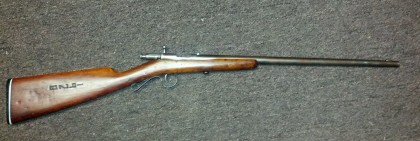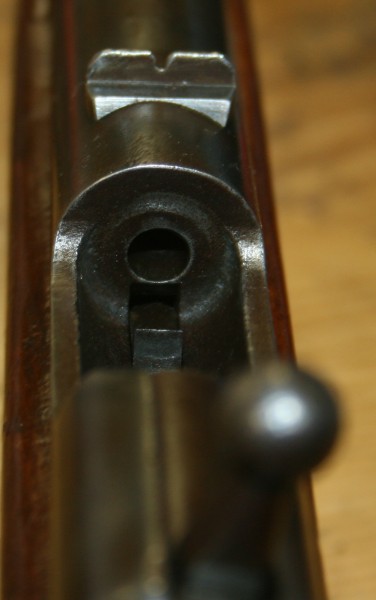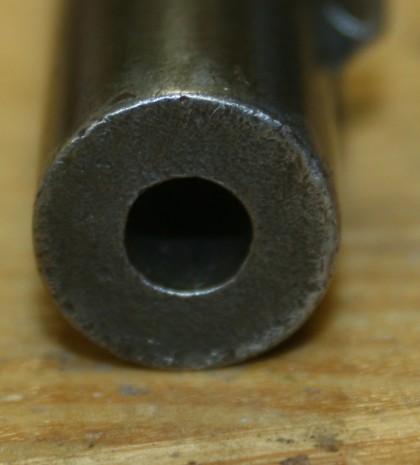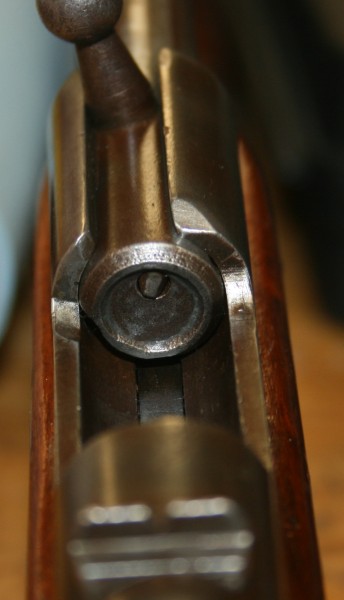[Guest bleg from sometimes guest blogger Jason. I didn’t know the answer to this so I asked him to post the question to all of you. – Sebastian]
I have a Winchester model 1902 rifle that’s been in the family since at least 1920, when my grandfather carved his name and the year into the stock.
The barrel is marked “22 SHORT LONG OR EXTRA LONG.” Does anyone know if its safe to use .22 Long Rifle or high velocity .22 Long Rifle in this gun? A .22LR round seems to chamber ok, but I can’t find any decent information on whether or not the higher pressures or different bullet geometry will cause problems if fired.
Update: some more pictures:






My old version of CotW lists them as identical in velocity (1000fps) with a 40 gr lead solid, LR being shorter and more efficient. SAAMI specs for 22 long and LR are both 24kpsi. So in this instance, being chambered for extra long (longer OAL than LR by 0.16 inches) and accepting of 22 long pressures should make standard LR safe. I have absolutely no information on pressure of extra long, so I would probably not exceed standard velocity. All this of course, not taking into account the state of the rifle and its firing condition.
TL:DR on that: They used the same bullet, pressure is the same as 22 long, so long as the rifle is otherwise safe, should be fine with standard pressure 22 LR.
Sorry. I ramble.
I would not use .22LR in this firearm. If you wish to fire the old girl
1 I’d take her to an accredited gunsmith, not just the turkey behind the counter, for an informed opinion
2 In my humble opinion and I may well be hooted down too, I’d use only .22shorts .22 Z or .22ZZ in her.
3 Go to your local rifle range to test you firearm. Far safer there if you encounter any difficulties. You may be surprised at the accuracy of this weapon to 50 meters.
4 Enjoy…
Do you know what the pressure is for 22 short, long or long rifle? Is there any significant difference between the three?
Merle
From what I understand, you should be able to use LR in it fine and standard velocities were similar between the two.
The correct answer is “no”.
Only because .22LR is an urban legend, like Bigfoot, the Easter Bunny and “reasoned discourse” from a gun control advocate.
What???
Merle
I’m hoping he means that it’s never been in stock or been seen since forever, thus, must be a myth.
Just found out it’s not actually an urban myth – a friend of mine actually saw some at a store!
We couldn’t afford any though, so we went back to shooting tin cans with milsurp .308.
http://ammoseek.com/ammo/22lr
Try this website, I’ve had good luck here.
Merle
Metallurgy was not as good then. It improved in the run-up to, and during WWII.
However, most bolt action .22 rimfires are ridiculously overbuilt in the breach/barrel. Probably due to the barrel blank being designed to handle a range of bigger/more powerful calibers, for cost concerns. Compare the barrel OD to a pocket pistol in .22RF or .25 acp to see this.
Granted, this is Wiki, so not absolute: http://en.wikipedia.org/wiki/.22_Extra_Long
Note that they indicate the chamber for the EL is longer than one for LR. Since the EL had more power, it would be logical to extrapolate that LR is ok to use in the EL, but not the reverse. They say ER ammo went out of production in 1935.
I suspect that the Hyper V types would be ok, due to lighter bullets and slower burning powder, but suggest that you refrain from using it.
Have you examined the chamber and bore? Since .22rf ammo was originally black powder, there may be significant erosion and pitting, depending on how strict the cleaning regimen was.
I’m guessing no serial #? Not common to have one on .22’s until mandated in the GCA ’68. Makes pinpointing the date of manufacture somewhat difficult.
There is some pitting on the outside of the barrel in a couple of spots, but the bolt and breech look decent, and the chamber and bore look perfect. The barrel does look way overbuilt.
We shot a bunch of .22 short through it last week without any issues.
There is no serial number. From the markings it was made sometime between 1902 and 1919.
The rifle has been in his family for almost 100 years and he wants to shoot it??? WHY??? It is a single shot .22 bolt rifle. What is so exciting about that round and that kind of shooting that he would risk damaging the bolt parts by firing a 100 year old rifle? I could see if it was something special or uncommon or a real hoot to shoot like a .45-70 from the late 1800’s or something like that. But with a true vintage piece of family history, why risk being the relative who owned it in 2013 and “just had to shoot it” and thus damaged parts that can no longer be had so that forever the rifle is broken or is missing original parts???
What’s the point of owning a gun if you can’t shoot it? I wouldn’t make a gun like that my regular shooter, but I’d never retire it. It would be like keeping a Model T you never took out for a drive every once in a while, even if you might agree driving it to work everyday is a bad idea.
“What’s the point of owning a gun if you can’t shoot it?”
I’d say we are trending toward the philosophical here, but that’s like saying what’s the point of owning anything that belonged to an ancestor, and not being able to use it. I wish I had, say, the harnesses for my grandfather’s team, but I’ve never owned a horse in my life. (Yet I know one of his horses, dead almost a century now, was named “Frank,” and that Frank’s team mate would let her traces go slack and let Frank pull the load, if you didn’t watch her.)
I have mixed emotions about guns, on that issue. I had a direct hand in “sporterizing” a lot of WWI and WWII relics, 40+ years ago, and today they are nothing very desirable — not desirable sporters, and no longer war relics. But the argument at the time was “What good are they if you aren’t going to use them?” And among those are items that were “fixed” until they didn’t work anymore.
Somewhere along the line the mystique and just plain antiquity of things that somehow managed to survive a century or more began to strike an emotional note with me, and now I think, damn if after the hundred-plus years this thing has survived, do I want to be the one who takes a chance of wrecking it, because I feel like playing with a slightly different toy today. There’s plenty of disposable toys on the shelf.
Not using it has the same effect as making it unusable by wrecking it. A cup unused is no different than a cup broken.
And seriously, it’s a .22. Shooting it is very low risk.
I think this is easily resolved by, “whatever floats your boat.” You own it, you do with it whatever you want to. :-)
Well, it was my grandfathers when he was a child, my dad used it when he was young, its the rifle with which I first learned to shoot, and now its the rifle my kids are learning to shoot with.
I do think such things should be used. Well cared for and not abused, but still used. What’s the point if it just sits on a shelf?
Nice. Preserving family history takes more than keeping an artifact on the mantelpiece, and you’re doing it right.
“What’s the point if it just sits on a shelf?”
Will you still be saying that when it is broken and parts are either unavailable or at least definitely not original? Will you still feel that way when it is above the mantel and all you can do every time you see it is to grit your teeth because you know that you broke it and can’t fix it, ever?
How is not shooting it different from it being broken and unshootable? Either way, you’re not shooting it. It’s just sitting on a shelf.
If you shoot it, and it breaks and is irrepairable, you can at least remember shooting it. If you never shoot it, you don’t even have that.
If you don’t shoot it – it STILL just hangs over the mantel.
If you do shoot it & it breaks it hangs over the mantel anyhow, so what is the difference?
To each their own.
Merle
Not shooting it because it’s broken is pretty much the same as not shooting it because I’m afraid to break it.
I have a small CNC mill, so I could probably fix anything short of a ruptured barrel.
To expand on Sebastian’s Model T analogy, maybe I’m a bit weird, but I use a 32 year old DeLorean for daily transportation. In the time I’ve had the car I’ve blown a head gasket, punched a hole through the engine block with a screwdriver (oops!), and ran over some big metal thing in the road which bent the frame and crushed the fuel tank, among other things. Despite all that the car still got me to and from work today. Most things can be fixed with care, time, and determination.
It never occurred to me not to shoot the rifle for fear of damaging it. My concern is safely. If the rifle breaks, as long as no one gets hurt, everything is still good.
I understand the desire to shoot “grand-dad’s gun” but I wouldn’t shoot it much and I’d only shoot .22 shorts just to stay on the safe side.
In practical terms, I’d watch the fired cartridges, and if you see any bulges that you don’t see with other, more modern guns, stop shooting it.
I have (knock on wood) never had a .22 that suffered any kind of structural failure, but I have fired ancient .22 rolling block single-shots, that would form “chipmunk cheeks” in front of the rim with high pressure cartridges, and blow out the rim or in front of the rim in some cases, due to excess headspace. That was never catastrophic, but it was dangerous. As long as the fired cases keep on coming out looking “normal,” you are probably OK.
I would comment that if your old rifle has a decent bore, you are very, very lucky, because in its youth it was used with blackpowder cartridges, and almost invariably at some point .22s were not cleaned adequately, resulting a very corroded bore.
I would use .22 Long.
22 long is even harder to find than LR, so good luck there.
Merle
Does the bolt lock via anything but the handle? Heavy as that barrel is (and assuming no through cracks, etc.), that is probably the main issue. You don’t want to be picking bits of .22 brass out of your teeth (and more tender places).
Very nearly all regular (not match grade) 22’s lock by the bolt handle only. One of the big accuracy improvements of the match grades came from having two (or more) locking lugs so that the cartridge would not “twist” upon firing. It wasn’t a big twist, but it made a difference, as did the dual extractors on some rifles.
Merle
Just the handle, but the handle seems reasonably beefy.